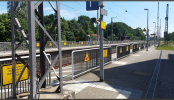With ETCS, I am not sure how much capacity would be released by reducing line speed through Welwyn, what might increase capacity slightly is enabling GN services to operate at 110mph, alongside LNER not calling at Stevenage. Stevenage would still get 4 fast trains an hour to London, just only with 700s.Would doing as much of the ECML as seems credible with current alignments save enough time to offset a meaningfully capacity increasing reduction in line speed through Welwyn without adversely impacting journey times?
If the ECML could reach 155mph, it would substantially reduce journey times, but 140mph would likely have a marginal effect of around 4 mins at most if all possible areas were done.
I'm not sure how much OLE work would be required for 140, since it seemed fine on headspans in the 1990s, with signalling being the primary impediment. Germany uses unstaffed partial barriers at 230kmh, so 145mph, so this should not be a major issue.


